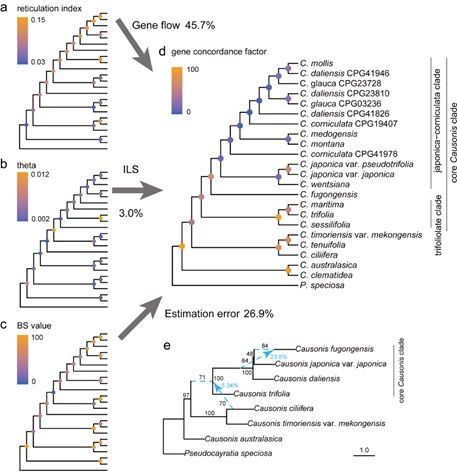Unraveling the mechanisms promoting species distribution range is crucial for understanding the dynamics of biodiversity under climatic changes. Hybridization and polyploidization, two processes that are believed to accelerate the generation of adaptive innovations, have been proposed to play important roles in facilitating the expansion of species distribution range.
The genus Causonis of the grape family provides an opportunity to explore the mechanisms underlying the contrasting patterns of species distribution ranges. Species of Causonis show great variations in distribution ranges, with most species in the “core clade” possessing a much wider range than those in the early-diverged lineages. Previous studies also suggested potential hybridization and polyploidization in Causonis, especially in the core Causonis clade with more widespread species. To investigate the roles of hybridization and polyploidization in species distribution range, strategies that bridge genomics and biogeography are required.
In a study recently published in BMC Biology, Prof. Chen Zhiduan’s team from the Institute of Botany of the Chinese Academy of Sciences and international collaborators reconstructed a reliable reticulate evolutionary history of Causonis in a robust biogeographic framework, using nuclear and plastid data from dense sampling. Nuclear gene tree conflicts were detected across the genus, particularly in the core Causonis clade, which were identified as mainly caused by extensive hybridization events (Fig. 1). With comprehensive methods, the study also revealed an allopolyploid origin of the widespread core Causonis clade, which might have promoted the accumulation of stress-related genes and thus facilitate the adaptation to changing environments (Fig. 2).
This study illustrates how hybridization and polyploidization might have contributed to the excessive disparity in species distribution ranges of Causonis. During glaciation in the early Oligocene, most Causonis lineages underwent extensive extinction and distribution range contraction, while the ancestor of core Causonis, equipped with duplicated genomes, might have survived the glaciation and flourished in continental Asia.
Species distribution modeling in this study reveals that the wide- and narrow-ranged species might have experienced different biogeographic pasts and may face different conservation issues under future climatic change. For example, the widespread species C. japonica tends to be more invasive in the future, while the narrow-ranged species C. ciliifera may be at risk of extinction due to the shrinking of adjacent suitable habitats (Fig. 3). This result suggests the importance of considering the specific evolutionary histories and genetic properties of the focal species when developing conservation strategies.
This work was supported by the National Natural Science Foundation of China, the National Key Research Development Program of China, the Youth Innovation Promotion Association CAS, and the K.C. Wong Education Foundation.

Fig. 1 Frequent gene flow and its contribution to gene tree conflicts.

Fig. 2 The allopolyploid origin of the core Causonis clade.

Fig. 3 The global distribution variations of wide-ranged Causonis japonica and narrow-ranged Causonis ciliifera under climate change.
Article Link: https://bmcbiol.biomedcentral.com/articles/10.1186/s12915-023-01718-8
Contact:
Prof. LU Limin,liminlu@ibcas.ac.cn
The Institute of Botany, Chinese Academy of Sciences
Unraveling the mechanisms promoting species distribution range is crucial for understanding the dynamics of biodiversity under climatic changes. Hybridization and polyploidization, two processes that are believed to accelerate the generation of adaptive innovations, have been proposed to play important roles in facilitating the expansion of species distribution range.
The genus Causonis of the grape family provides an opportunity to explore the mechanisms underlying the contrasting patterns of species distribution ranges. Species of Causonis show great variations in distribution ranges, with most species in the “core clade” possessing a much wider range than those in the early-diverged lineages. Previous studies also suggested potential hybridization and polyploidization in Causonis, especially in the core Causonis clade with more widespread species. To investigate the roles of hybridization and polyploidization in species distribution range, strategies that bridge genomics and biogeography are required.
In a study recently published in BMC Biology, Prof. Chen Zhiduan’s team from the Institute of Botany of the Chinese Academy of Sciences and international collaborators reconstructed a reliable reticulate evolutionary history of Causonis in a robust biogeographic framework, using nuclear and plastid data from dense sampling. Nuclear gene tree conflicts were detected across the genus, particularly in the core Causonis clade, which were identified as mainly caused by extensive hybridization events (Fig. 1). With comprehensive methods, the study also revealed an allopolyploid origin of the widespread core Causonis clade, which might have promoted the accumulation of stress-related genes and thus facilitate the adaptation to changing environments (Fig. 2).
This study illustrates how hybridization and polyploidization might have contributed to the excessive disparity in species distribution ranges of Causonis. During glaciation in the early Oligocene, most Causonis lineages underwent extensive extinction and distribution range contraction, while the ancestor of core Causonis, equipped with duplicated genomes, might have survived the glaciation and flourished in continental Asia.
Species distribution modeling in this study reveals that the wide- and narrow-ranged species might have experienced different biogeographic pasts and may face different conservation issues under future climatic change. For example, the widespread species C. japonica tends to be more invasive in the future, while the narrow-ranged species C. ciliifera may be at risk of extinction due to the shrinking of adjacent suitable habitats (Fig. 3). This result suggests the importance of considering the specific evolutionary histories and genetic properties of the focal species when developing conservation strategies.
This work was supported by the National Natural Science Foundation of China, the National Key Research Development Program of China, the Youth Innovation Promotion Association CAS, and the K.C. Wong Education Foundation.

Fig. 1 Frequent gene flow and its contribution to gene tree conflicts.

Fig. 2 The allopolyploid origin of the core Causonis clade.

Fig. 3 The global distribution variations of wide-ranged Causonis japonica and narrow-ranged Causonis ciliifera under climate change.
Article Link: https://bmcbiol.biomedcentral.com/articles/10.1186/s12915-023-01718-8
Contact:
Prof. LU Limin,liminlu@ibcas.ac.cn
The Institute of Botany, Chinese Academy of Sciences
